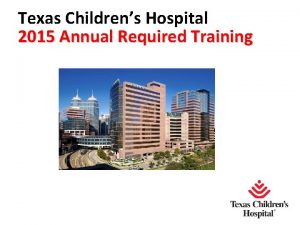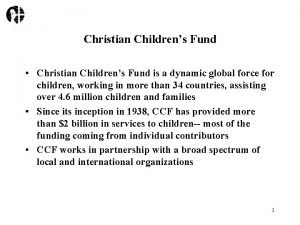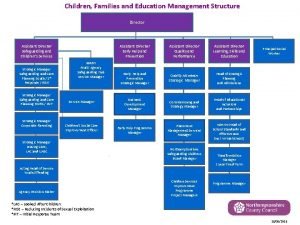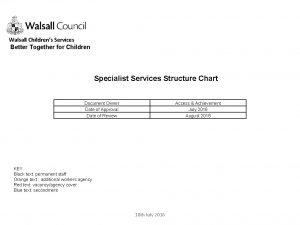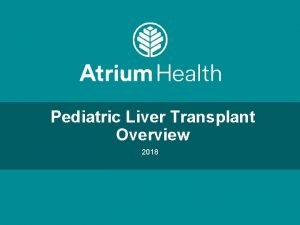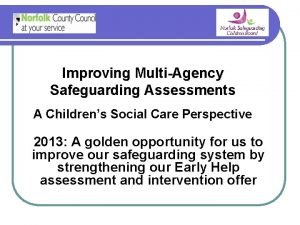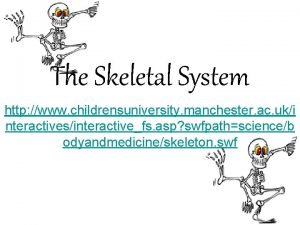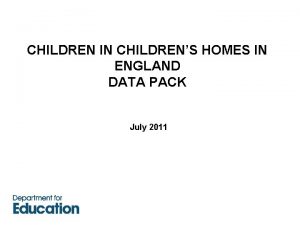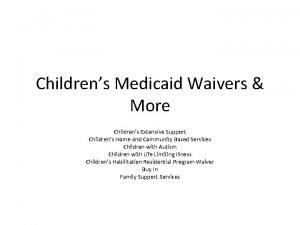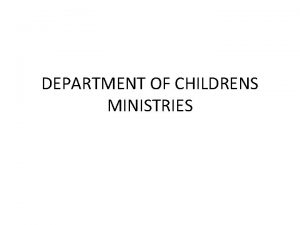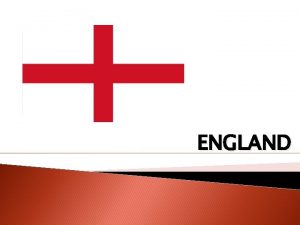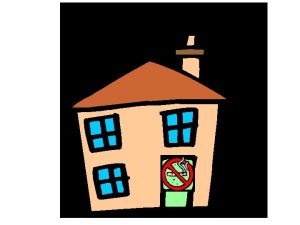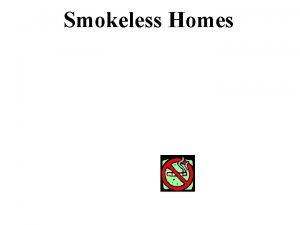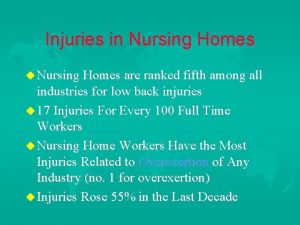CHILDREN IN CHILDRENS HOMES IN ENGLAND DATA PACK





















- Slides: 21

CHILDREN IN CHILDREN’S HOMES IN ENGLAND DATA PACK July 2011

Purpose of this Data Pack Children’s homes are an important placement option for looked after children. Stable effective care requires strong partnerships between local authorities and children’s homes providers, so that children can benefit from planned admissions, are placed in homes best able to meet their needs where their progress is continually reviewed, and are supported to move when they have been properly prepared and feel ready to take this step. This pack: § includes information about the children who depend on children’s homes for their care; § shows how different local authorities use children’s homes; and § is intended to help local authorities understand how children’s homes contribute to achieving good quality stable outcomes for the children they look after. For example, why do some authorities place more children in residential care than others? This information helps build a picture about how children’s homes are used as a placement option but does not include information about the quality of individual homes. This information is available from Ofsted at http: //www. ofsted. gov. uk/Ofsted-home/Inspection-reports 2

About this pack § Unless otherwise stated, the information in this pack is drawn from the Df. E statistical collection about looked after children (SSDA 903) [See: http: //www. education. gov. uk/rsgateway/DB/SFR/s 000960/index. shtml for further information] § The data relates only to looked after children who are placed in children’s homes and hostels and so excludes information about children placed in residential care as part of short break (respite) care arrangements § The placement of individual looked after children will be determined by local authority policies and their arrangements for commissioning placements. But children should be matched to the placement assessed as most likely to meet their needs and should be consulted about placement moves. 3

Around 10% of looked after children are in children’s homes and hostels or secure units. 6, 200 children were placed in these settings at 31 March 2010, of whom 5, 000 were in regulated children’s homes. In 2009 -10 3, 100 children started to be looked after in these settings. 4 See Annex for details of placement type definitions 38% of children in homes and hostels not subject to children’s homes regulations at 31 March 2010 were UASC (unaccompanied asylum seeking children) - 32% of 16 year olds and 43% of 17 year olds. This compares with 2% of children in regulated homes and hostels. (Numbers of UASC in secure units are negligible. )

Children’s homes, hostels and secure units cater for children of all ages. In practice most children are aged over 12. This is the sum of the other lines This chart shows the stock of children at a point in time but the picture is similar for the flow of children starting to be looked after 5

Boys are more likely than girls to be placed in regulated children’s homes, even after allowing for the fact that there are more boys than girls in the looked after population. 27% of boys starting to be looked after aged 15 are placed in regulated children’s homes. 60% of children in regulated children’s homes are boys 6

Children placed in children’s homes are less likely to have abuse or neglect identified as being the primary reason for being looked after than children in other placements. Research indicates that some of these children may have experienced neglect or abuse that has not been identified 1 About 95% of unaccompanied asylum seeking children are looked after because of absent parenting. They have been excluded from this chart. 1. https: //www. education. gov. uk/publications/standard/publicationdetail/page 1/DCSF-RBX-09 -04 7

Research on Children’s Homes 8 § Most young people were complimentary about the residential care they received, generally felt safe where they were living and said that there was an adult who would stand up for them. § But, a third of residents said they had considered killing themselves at some stage during the previous month; nearly half of whom were confirmed by their social workers as having self-harmed or attempted suicide. § Residents mostly showed improvement across general measures of behavioural, emotional and social difficulties as well as education. § The benefits that accrued during residence did not necessarily persist on departure and follow-up outcomes were not encouraging. (Sinclair and Gibbs, 1998; Clough et al, , 2006; Berridge et al. , 2008; Stein, 2009).

9 Most children in residential care leave care after they turn 18 but a significant minority (46%) leave earlier – a higher proportion than for children in foster care. But this varies a lot by type of home. Children are unlikely to remain in secure units until 18, but are very likely to stay on in homes and hostels not subject to regulations

10 The duration of placements in regulated children’s homes is quite similar to foster placements though fewer last longer than a year – 20% compared with 25%. Placements in secure units are far less likely to last over a year (3%) while placements in unregulated homes are less likely to last under 8 weeks (30%). Placements in residential schools are most likely to be of long duration, followed by placements with parents. UASC are more likely to have long placements, although some do still have very short placements.

11 For some children being placed in a children’s home is their first placement. But 30% of children in children’s homes have had at least 5 previous placements. All looked after children Children’s homes, hostels and secure units 32% of children in foster placements are on their first placement, compared to 24% of children in regulated children’s homes. This chart doesn’t show when children were first placed in a children’s home.

15% of looked after children have lived in a children’s home, hostel or secure unit at some point: 3, 400 (5%) have since moved to another placement. 12 The bars show the number of children in each type of placement at 31 March 2010 who have previously been in a children’s home or hostel or secure unit On average a child’s first placement in a children’s home, hostel or secure unit is their third placement although some are placed in homes when they first start to be looked after.

Children in all types of homes and hostels are more likely to be placed over 20 13 miles from their local communities than those in foster care (33% vs. 14%). They are also more likely to be placed outside the local authority boundary (44% vs. 33%). 45% of children in regulated homes and hostels live within the Local Authority and fewer than 20 miles from home, but 30% live outside the LA and over 20 miles from home. This compares with 58% (in LA <20 miles) and 11% (outside LA >20 miles) for children in foster care.

More than half of the children in children’s homes, hostels and secure units are 14 in private or voluntary provision, but this varies by type of home and whether the child is placed inside or outside the LA area. 85% of children in unregulated homes and hostels are in private or voluntary provision.

Number of children placed in regulated children’s homes at 31 March 2010 Local authorities make very different use of regulated children’s homes – from 15 placing no children to one authority that places 225 children in children’s homes. On average, at 31 March 2010, LAs had 33 children in children’s homes. Three LAs had no children placed in children’s homes (City of London, Rutland, Isles of Scilly)

There is also a lot of variation between LAs as to whether they place children inside or outside the LA boundary. 16 Where are children placed? § § § 2, 300 (47%) of the children placed in regulated children’s homes were placed outside the LA area On average LAs placed 55% of their children in children’s homes outside the local authority area Twenty-two LAs placed all children outside the local authority area Who is responsible for the children placed in children’s homes? § § § On average 49% of the children living in children’s homes in a LA area were the responsibility of another LA Nineteen LAs had no children placed in their area by other LAs For eighteen LAs the only children living in children’s homes in their area were the responsibility of other LAs Do Local Authorities fully utilise the provision in their own areas? § § Most LAs (130: 86%) simultaneously placed children in residential care outside their area and had children placed within their area from other LAs may be looking for specific specialised support when they decide to place outside of their area

17 Costs of Children’s Home care See - Unit Costs of Health and Social Care - PSSRU (2010) http: //www. pssru. ac. uk/pdf/uc/uc 2010. pdf Cost implications § The cost of care in a local authority children’s home is estimated at £ 2, 689 per resident week (£ 2, 881 including external services). § In comparison, the cost of care in the non-statutory sector is estimated at £ 2, 408 per resident week (£ 2, 494 including external services). § These costs include capital costs (buildings, land, equipment) and revenue costs (salary and other revenue costs). § The average cost of foster care is estimated at £ 676 per child per week. This is much less than the cost of a children's home placement but children's homes have a higher proportion of older children who are likely to have more complex needs which increases costs.

Conclusions § § 18 For the first time - the Children’s Homes Data Pack brings together in one place all the data that is held by Df. E about children who rely on children’s homes. This information is intended to help local authorities think about the use they make of children’s homes so that residential care offers each child a good quality, stable, experience. The data suggests a range of questions for individual local authorities to consider in reviewing their placement and commissioning strategies and in deciding on placements for individual children. These include: – Are there groups of children whose assessed needs are such that placement in a children’s home is likely to be the best option; and how is this understanding reflected in the range and numbers of children’s homes placements commissioned by the authority? – Does the authority have access to sufficient children’s homes placements, so that a move to residential care enables young people to continue to be supported by suitable local services? – Where children are placed at a distance from their local community how will the local authority support them, so that they can make a planned transition when they are ready for the next move in their lives? – How does the authority work with children’s homes to promote children’s emotional health and well being, so that the child can access to additional mental health support where necessary? – Does the authority maximise sustained outcomes for individual children so that the costs of placement represent real value for money?

19 Next steps and future publications § This data pack emphasises the continuing contribution children’s homes make to supporting looked after children, who will often be older and have many previous placements behind them. § Statistics on children looked after for 2010 -11 will be published in September 2011. § Df. E and Ofsted officials will be co-operating on a revised data pack with more comprehensive information both updating this data and incorporating information on quality, supply and provision of children’s homes. This data pack will be issued in late autumn 2011. § We very much welcome feedback and suggestions on how the pack might be developed. § Please send any ideas for further analysis that we may be able to include in future publications to Isabella. Craig@education. gsi. gov. uk § For policy questions please contact Mark. Burrows@education. gsi. gov. uk or Shelley. Stewart-Murray@education. gsi. gov. uk

Annex: Placement type definitions (1) 20 The definitions used in this data pack are the same as those that given in the Guidance Notes for local authorities for completion of the SSDA 903 data return Placed in secure accommodation This definition is used for children's placements in secure accommodation, either where section 25 of the Children Act applies (or would apply after 72 hours), or where the child is subject to a court ordered secure remand. Placed in homes and hostels This definition is used for children's homes which fall within the meaning of the Children's Homes Regulations (1991); this includes maintained, controlled and assisted community homes (except where the child is placed in a secure unit) voluntary sector children's homes, and private children's homes; as well as schools that are dual-registered as children's homes, as defined in section 1 (6) of the Care Standards Act 2000. Hostels and other supportive residential settings not subject to the Children’s Homes Regulations This definition is used for placements in residential accommodation that are not subject to the Children’s Homes Regulations, but where some supervisory or advice staff are employed (although they do not have to live on the premises). This placement code includes hostels, foyers; lodgings, flats and bedsits where staff or advice workers are specifically employed and available to provide support to the residents. These support staff do not have to live on the premises, but must be an integral part of a formal support service provided by the place of residence.

Annex: Placement type definitions (2) Residential care homes Registered Homes Act 1984 Applies to residential care homes and nursing homes that fall within the scope of the Registered Homes Act. The services they provide will normally include an element of personal care or nursing care. ‘Personal care’ in this instance generally means help with personal activities such as feeding, washing, etc. This category does not include hospitals, or facilities provided by NHS/health trusts. NHS/health trust or other establishment providing medical/nursing care. This definition refers to the placement of looked after children in hospitals of all kinds when the child is placed there as part of the care plan. (Temporary spells in hospital receiving treatment for injuries or illness do not fall in this category and are not normally recorded on the SSDA 903); the definition would also be used for other facilities provided by health services. Residential family centre or mother and baby unit This definition applies to looked after children placed in a residential family centre, as defined in section 4 (2) of the Care Standards Act 2000, or a placement in a residential facility for mothers and babies (except hospitals and other NHS facilities). Young Offender Institute or Prison This definition applies to looked after young people who are accommodated in one of these settings. These will generally be boys (either on remand or serving a sentence) who are the subjects of a care order. School This definition applies to children placed in a residential school, except schools that are dual-registered as children's homes, as defined in section 1(6) of the Care Standards Act 2000. 21
 Pack it out pack it in
Pack it out pack it in Texas children's hospital moli
Texas children's hospital moli The christian childrens fund
The christian childrens fund Childrens services
Childrens services Walsall childrens services
Walsall childrens services Levine childrens
Levine childrens National sovereignty and childrens day
National sovereignty and childrens day Kirklees safeguarding childrens board
Kirklees safeguarding childrens board Traditional literature quiz
Traditional literature quiz Childrens university of manchester
Childrens university of manchester Longman children's picture dictionary
Longman children's picture dictionary Black childrens memorial
Black childrens memorial Grades of hemorrhagic shock
Grades of hemorrhagic shock History of childrens literature
History of childrens literature Colorado childrens book award
Colorado childrens book award Home data pack
Home data pack Kw luxury homes international
Kw luxury homes international Qapi template for nursing homes
Qapi template for nursing homes Taino diet
Taino diet Taino homes
Taino homes Snug bug homes
Snug bug homes Rent to own homes in stilwell ok
Rent to own homes in stilwell ok

